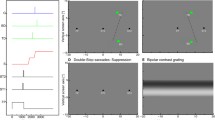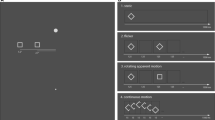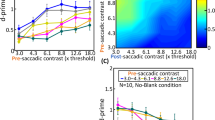Abstract
During fast, saccadic eye movements visual perception is suppressed. This saccadic suppression prevents erroneous and distracting motion percepts resulting from saccade induced retinal slip. Although saccadic suppression occurs over a substantial time interval around the saccade, there is no “perceptual gap” during saccades. The mechanisms underlying this temporal perceptual filling-in are unknown. When subjects are asked to perform temporal interval judgements of stimuli presented at the time of saccades, the time interval following the termination of the saccade appears longer than subsequent intervals of identical length. This illusion is known as “chronostasis”, because a clock presented at the saccade target seemingly stops for a moment. We test whether chronostasis is a global mechanism that may compensate for the temporal gap associated with saccadic suppression. We show that a clock positioned halfway between the initial fixation point and the saccade target does not exhibit prolongation of the interval following the saccade. The characteristical distortion of temporal perception occurred only in the case of a clock being located at the saccade target. This result suggests a local, object-specific mechanism underlying the stopped clock illusion that might originate from a shift in attention immediately preceding the eye movement.


Similar content being viewed by others
References
Alexander I, Thilo KV, Cowey A, Walsh V (2005) Chronostasis without voluntary action. Exp Brain Res 161:125–132
Allan LG (1979) The perception of time. Percept Psychophys 26:340–344
Buhusi CV, Meck WH (2005) What makes us tick? Functional and neural mechanisms of interval timing. Nat Rev Neurosci 6:755–765
Deubel H, Schneider WX (1996) Saccade target selection and object recognition: evidence for a common attentional mechanism. Vision Res 36:1827–1837
Deubel H, Irwin DE, Schneider WX (1999) The subjective direction of gaze shifts long before the saccade. In: Becker W, Deubel H, Mergner T (eds) Current oculomotor research: physiological and psychological aspects. Plenum, New York pp 65–70
Haggard P, Clark S, Kalogeras J (2002) Voluntary action and conscious awareness. Nat Neurosci 5:382–385
Hodinott-Hill I, Thilo KV, Cowey A, Walsh V (2002) Auditory chronostasis: hanging on the telephone. Curr Biol 12:1779–1781
Hoffman JE, Subramaniam B (1995) The role of visual attention in saccadic eye movements. Percept Psychophys 57:787–795
Irwin DE, Gordon RD (1998) Eye movements, attention and trans-saccadic memory. Vis Cogn 5:127–155
Kowler E, Anderson E, Dosher B, Blaser E (1995) The role of attention in the programming of saccades. Vis Res 35:1897–1916
Mauk MD, Buonomano DV (2004) The neural basis of temporal processing. Annu Rev Neurosci 27:307–340
Morrone MC, Ross J, Burr D (2005) Saccadic eye movements cause compression of time as well as space. Nat Neurosci 8:950–954
Park J, Schlag-Rey M, Schlag J (2003) Voluntary action expands perceived duration of its sensory consequence. Exp Brain Res 149:527–529
Peterson MS, Kramer AF, Irwin DE (2004) Covert shifts of attention precede involuntary eye movements. Percept Psychophys 66:398–405
Rose D, Summers J (1995) Duration illusions in a train of visual stimuli. Perception 24:1177–1187
Ross J, Morrone MC, Goldberg ME, Burr DC (2001) Changes in visual perception at the time of saccades. Trends Neurosci 24:113–121
Tse PU, Intriligator J, Rivest J, Cavanagh P (2004) Attention and the subjective expansion of time. Percept Psychophys 66:1171–1189
Volkmann FC, Moore RK (1978) Saccadic eye movements and the perception of a clear and continuous vusual world. In: Armington JC (ed) Visual psychophysics and physiology. Academic, London, pp 353–362
Yarrow K, Rothwell JC (2003) Manual chronostasis: tactile perception precedes physical contact. Curr Biol 13:1134–1139
Yarrow K, Haggard P, Heal R, Brown P, Rothwell JC (2001) Illusory perceptions of space and time preserve cross-saccadic perceptual continuity. Nature 414:302–305
Yarrow K, Haggard P, Rothwell JC (2004a) Action, arousal, and subjective time. Conscious Cogn 13:373–390
Yarrow K, Johnson H, Haggard P, Rothwell JC (2004b) Consistent chronostasis effects across saccade categories imply a subcortical efferent trigger. J Cogn Neurosci 16:839–847
Author information
Authors and Affiliations
Corresponding author
Rights and permissions
About this article
Cite this article
Georg, K., Lappe, M. Spatio-temporal contingency of saccade-induced chronostasis. Exp Brain Res 180, 535–539 (2007). https://doi.org/10.1007/s00221-007-0876-5
Received:
Accepted:
Published:
Issue Date:
DOI: https://doi.org/10.1007/s00221-007-0876-5




